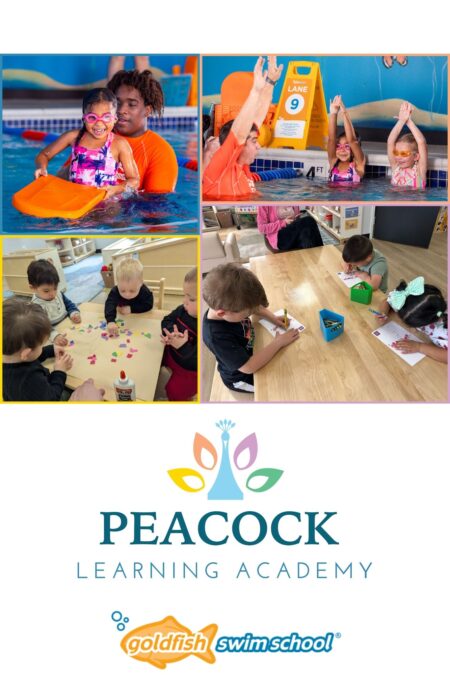The Power of Early Swim Lessons: How Water Helps Young Minds Thrive in the Classroom

The Power of Early Swim Lessons: How Water Helps Young Minds Thrive in the Classroom
From the moment a child takes their first breath, they are constantly learning. Every movement, every interaction, and every experience shapes their cognitive, physical, and emotional development. While many parents focus on traditional early childhood education, there’s a powerful, science-backed tool that can help children excel both physically and academically—swimming lessons.
At Peacock Learning Academy, we’re excited to partner with Goldfish Swim School in Wayne, an organization dedicated to using scientific research to develop their swim curriculum. But how exactly does early swim instruction connect to learning in the classroom? Let’s dive into the research and explore the many ways swimming at an early age can enhance brain development, improve learning skills, and set children up for success in school.
The Science Behind Early Swimming and Cognitive Development
Research consistently shows that early movement experiences play a critical role in brain development. Swimming, in particular, is a full-body activity that engages multiple sensory systems at once, leading to enhanced brain growth and cognitive function.
A landmark study conducted by Griffith University in Australia found that children who participated in early swimming lessons were, on average, six to 15 months ahead of their non-swimming peers in areas such as language development, math, literacy, and social skills by the time they started school. The study, which spanned three years and involved over 7,000 children, provides compelling evidence that swimming from an early age has a direct impact on school readiness.
The reason behind this cognitive boost lies in how swimming stimulates both hemispheres of the brain through bilateral movement—coordinating arms, legs, breathing, and balance simultaneously. This type of cross-lateral movement is known to strengthen neural pathways, which can improve skills like:
- Reading and comprehension
- Mathematical reasoning
- Memory and concentration
- Problem-solving abilities
Swimming and Executive Function: The Key to Learning Success
Executive function refers to a child’s ability to plan, focus attention, remember instructions, and manage multiple tasks—all essential skills for success in a structured classroom environment. Studies have shown that early swim instruction helps develop:
- Improved Focus and Attention
Swimming lessons require children to listen to multi-step instructions, process information quickly, and execute precise movements. This trains their brains to focus and stay engaged, which directly translates to better concentration in the classroom. - Stronger Working Memory
A child who can remember the steps of a swim stroke is also strengthening their working memory, which is crucial for learning new words, solving math problems, and following multi-step directions in school. - Enhanced Self-Regulation and Impulse Control
Swimming is a structured activity that requires patience, turn-taking, and self-discipline—skills that are vital in a classroom setting. Children who participate in swim lessons learn how to control their impulses, follow rules, and wait their turn, all of which contribute to positive classroom behavior.
Sensory and Motor Development: The Foundation for Writing and Learning
Swimming is one of the best sensory-rich experiences for young children. The buoyancy of water, combined with resistance, temperature changes, and body movement, engages multiple sensory systems at once.
This is particularly beneficial for fine motor control—the development of small muscle movements in the hands and fingers, which are critical for tasks like writing, drawing, and using scissors.
Swimming helps improve:
- Grip strength and hand coordination (needed for holding a pencil)
- Core strength and posture (which affects sitting at a desk for extended periods)
- Balance and spatial awareness (important for navigating a classroom and playground)
For children who struggle with sensory processing issues, swimming provides a calming, proprioceptive experience that helps regulate emotions and improve focus in learning environments.
Swimming and Social-Emotional Growth: The Key to Classroom Confidence
Beyond academic skills, swimming fosters essential social-emotional development. A study from the University of Iceland found that children who engaged in early swim lessons showed greater self-confidence, independence, and emotional resilience compared to those who did not.
- Increased Confidence and Risk-Taking
Learning to swim requires overcoming fears, setting goals, and mastering new skills—all of which build confidence. When children feel successful in the water, that confidence carries over into the classroom, where they’re more willing to participate, ask questions, and tackle new challenges. - Better Social Skills and Peer Interaction
Swim classes encourage cooperation, turn-taking, and group participation, which are fundamental classroom skills. Children learn how to follow directions from instructors, work alongside peers, and support one another, all of which contribute to stronger classroom relationships. - Emotional Resilience and Stress Reduction
Water has a naturally calming effect on the nervous system. Swimming reduces stress and anxiety through deep breathing, rhythmic movement, and sensory input, making it an excellent activity for children who experience classroom anxiety or difficulty managing emotions.
Why Goldfish Swim School’s Research-Based Approach Matters
At Goldfish Swim School in Wayne, their curriculum is backed by research in childhood development, motor learning, and cognitive science. Their teaching methods focus on:
- Gentle, confidence-building techniques to ensure children feel safe and supported
- Play-based learning to make swim lessons engaging and developmentally appropriate
- Small class sizes and individualized attention to help every child progress at their own pace
Their scientifically designed swim programs align with the latest research, reinforcing the idea that early swimming is more than just a life-saving skill—it’s a powerful tool for academic and personal growth.
How Parents Can Support Learning Through Swimming
If you’re looking to give your child an academic advantage, consider integrating regular swim lessons into their routine.
Here’s how you can support their learning:
- Enroll early – Research suggests that starting swim lessons before age 5 has the greatest impact on cognitive development.
- Encourage movement-based learning – Activities that involve both sides of the body and brain, like swimming, help reinforce academic skills.
- Talk about what they learn in lessons – Discussing what your child practiced in the pool strengthens memory and verbal communication skills.
- Connect swim lessons to other learning activities – Counting strokes, identifying colors, and following patterns in the water can reinforce early math and literacy skills.
Conclusion: Making Waves in Learning and Development
The science is clear—early swim lessons do more than teach water safety. They lay the foundation for cognitive development, motor skills, executive function, and social-emotional learning, all of which are crucial for academic success.
Our partnership with Goldfish Swim School in Wayne ensures that children receive research-backed, high-quality swim instruction that aligns with what we know about early childhood brain development.
If you want to give your child an edge in the classroom while teaching them a vital life skill, now is the time to get them in the water!
Ready to Dive In?
Peacock Learning Academy families can now enjoy exclusive opportunities with Goldfish Swim School in Wayne. Contact us today to learn more about how early swim lessons can help your child thrive both in and out of the classroom!
References
For more information about early swim lessons - Early Swim Lessons Help Intellectual Development, Study Says

Sejal Dave, Owner and Director
Peacock Learning Academy


